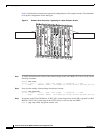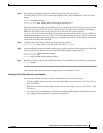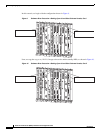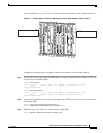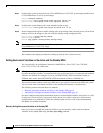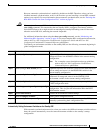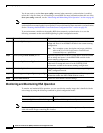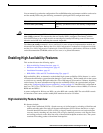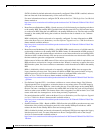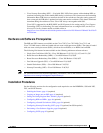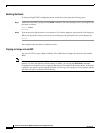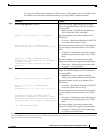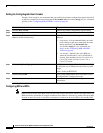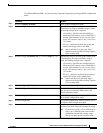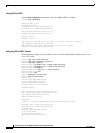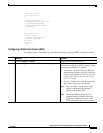
42
Route Switch Processor (RSP8) Installation and Configuration Guide
OL-4920-02
Enabling High Availability Features
SLCR is disabled by default and needs to be manually configured. When SLCRis enabled, and more
than two linecards crash simultaneously, all line cards will be reset.
For more information on how to configure SLCR, refer to the Cisco 7500 Single Line Card Reload
feature module at
http://www.cisco.com/univercd/cc/td/doc/product/software/ios120/120newft/120limit/120s/120s13
/slcr.htm.
• Route Processor Redundancy (RPR)—Speeds recovery of a failed router by accelerating switchover
to the standby RSP. The standby RSP is preinitialized with the same full Cisco IOS software image
as on the active RSP. When the active RSP fails, the standby RSP takes over. The line cards are OIR
inserted by the standby RSP during the switchover. Switchover time is reduced to 4 to 5 minutes
with RPR.
RPR is disabled by default, and needs to be manually configured. For more information on RPR,
refer to the Route Processor Redundancy and Fast Software Upgrade on Cisco 7500 Series Routers
feature module available online at
http://www.cisco.com/univercd/cc/td/doc/product/software/ios120/120newft/120limit/120st/120st
16/st_rpr7x.htm.
• Route Processor Redundancy Plus (RPR+)—Like RPR, RPR+ speeds recovery of a failed router by
accelerating switchover to the standby RSP. The RPR+ feature, an enhancement of RPR, prevents a
VIP from being reset and reloaded when a switchover occurs between the active and standby RSPs.
Switchover time is reduced because VIPs are not reset, microcode does not reload on the VIPs, and
the time needed to parse the configuration is eliminated.
Online removal of the active RSP causes all line cards to reset and reload, which is equivalent to an
RPR switchover, and results in a longer switchover time. When it is necessary to remove the active
RSP from the system, first issue a switchover command to switch from the active RSP to the standby
RSP.
RPR+ is disabled by default, and needs to be manually configured. RPR+ does not support the
Legacy interface processor card. The system will default to RPR if the router includes an Legacy
interface processor card. For more information on how to configure RPR+, refer to the
RPR+ on Cisco 7500 Series Routers feature module, available online at
http://www.cisco.com/univercd/cc/td/doc/product/software/ios120/120newft/120limit/120st/120st19/st
_rpr2.htm.
• Fast Software Upgrade (FSU)—Accelerates switchover to a new software image. Fast Software
Upgrade permits users to upgrade to an interim release or next minor release Cisco IOS image by
uploading it to the standby RSP first. After loading the new Cisco IOS image on the standby RSP,
the user can issue a command to switch to the standby RSP, and all the line cards will be reloaded,
similar to what occurs in RPR. This feature allows users to upgrade Cisco IOS on their Cisco 7500
routers with much less interruption to service than previously experienced.
For more information on FSU, refer to the Route Processor Redundancy and Fast Software Upgrade
on Cisco 7500 Series Routers feature module available online at
http://www.cisco.com/univercd/cc/td/doc/product/software/ios120/120newft/120limit/120st/120st
16/st_rpr7x.htm.
• Stateful Switchover (SSO)—Based on RPR+, SSO allows the active RSP to pass the necessary state
information of key routing and interface protocols to the standby RSP upon switchover, which
reduces the time for the standby RSP to learn and converge routes.
SSO is disabled by default, and needs to be manually configured. SSO does not support the Legacy
interface processor cards. For more information on how to configure SSO, refer to the Stateful
Switchover feature module available online at
http://www.cisco.com/univercd/cc/td/doc/product/software/ios120/120newft/120limit/120s/120s22/sso
120s.htm.



